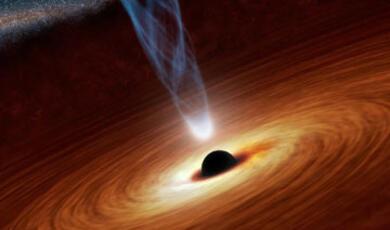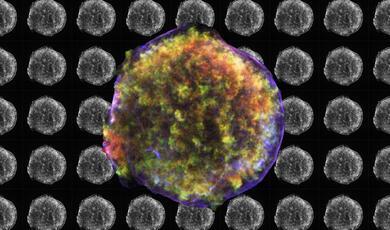Supernova! What makes stars explode?
Share
- Details
- Text
- Audio
- Downloads
- Extra Reading
The death of a star in a supernova explosion is one of the most dramatic acts of violence in the Universe. In mere seconds, a mighty star self-detonates in a blast that consumes both itself and many of its surrounding planets. It’s something that worries a lot of people, particularly the thought that our Sun might one day “go supernova”. But how likely is this? What are the factors that make some stars explode and others sustain themselves for incredibly long stretches of time?
Download Text
SUPERNOVA!
WHAT MAKES STARS EXPLODE?
HEATHER COUPER
The death of a star in a supernova explosion is one of the most dramatic acts of violence in the Universe. In mere seconds, a mighty star self-detonates in a blast that consumes both itself and many of its surrounding planets. It’s something that worries a lot of people - particularly the thought that our Sun might one day “go supernova”.
But we’re safe. The Sun is too average for that; it is a celestial lightweight. For it is the mass of a star that determines how it lives and dies. Only the very rare heavyweight stars have a gory end in sight. Stars much heavier than the Sun have higher core temperatures; they rip through their nuclear fuel at a profligate pace, and burn themselves out correspondingly quickly. Our Sun, and stars less massive than it, are cooler-hearted and more conservative: they can look forward to lifetimes lasting thousands of millions of years instead of the frenetically-lived few million years of their weightier cousins.
Low-mass stars like the Sun run out of fuel after some ten thousand million years. At this time, their central hydrogen reserves - one-tenth of the total mass - have been converted to helium. But only in these central regions are temperatures high enough for the fusion reactions to occur. The star has lost its energy source, and gravity reasserts itself, crushing tight the dead helium core. These internal traumas have little effect on a star’s appearance until the core’s temperature has risen so steeply under compression that a thin shell of hydrogen bordering it suddenly starts burning to helium. The star now has a short-lived power source, sited much higher up from the centre. There is less outer gas in the way to impede the outward flow of energy, and the effect is dramatic. Engulfing its nearest planets, the star billows out under the surge of unleashed energy, finally settling down in a new state of balance a hundred times bigger than it was before. This fate will one day befall our Sun - and its family. Earth may be spared, but Mercury and Venus will almost certainly be gobbled up and incinerated as our star becomes a red giant.
Some red giants are so huge that a ray of light would take almost an hour to cross them. Their cool surfaces are covered with starspots (similar to sunspots) as wide as Earth’s orbit ‘stellar wind’. But for all their vastness, they’re as insubstantial as thistledown, as rarefied as the best laboratory ‘vacuum’. With most of their matter concentrated in the collapsed core, gravity has little hold on their outer layers. They wobbled like cosmic blancmanges as their surface layers slowly pulsate in and out, causing them to change uncertainly in both size and brightness. Orion’s brilliant Batelgeuse - ‘the armpit of the Sacred One’ - is one such long-period variable star which brightens and fades by a factor of two over a period of about a year.
But it seems that there’s a limit to what an old star can take. In the end, it very gently puffs off its distended atmosphere. For an instant of cosmic time, a few tens of thousands of years, we see the red giant’s remains as a planetary nebula - an ever-expanding shell of gas excited to shine by the now-revealed core. Even that soon disperses into space.
Massive stars are made of much sterner stuff. Later on in this talk, I’ll be looking at the internal changes they can take on board as they approach the ends of their lives. But as I have already said, the final outcome is death by fire, in a supernova explosion. These celestial funeral pyres were something that the Chinese astronomers of old were exceedingly adept at recording. For instance, on 7 December AD 185, they noticed a brilliant new sky-sight: ‘A great star appeared within Nan-mên. It was as large as half a mat; it displayed the five colours; and it scintillated.’ In modern terminology, the ‘guest star’ was a supernova, an exploding star about a billion times brighter than the Sun. To the Chinese, however, the star had a much more practical importance. According to Chinese astrology, the sky was a mirror of the Earth - meaning the country of China, and the Emperor who embodied it. The people who watched the sky were concerned mainly with the portents it displayed. Guest stars were usually bad news: the star of AD185, for example, ‘meant insurrection’, and indeed ‘the governor of the metropolitan region Yuan-Shou punished and eliminated the middle officials ... and several thousand people were killed’.
Stripped of their astrological interpretations, however, the Chinese records are invaluable to modern astronomers. The Eastern astronomers measured positions of unexpected objects in the sky as accurately as they could, relative to their constellation patterns. By identifying the Chinese constellations and stars, we can therefore pin down the positions of the new stars. If the Chinese say the star moved, it must have been a comet; if it was stationary, it was either a nova or a supernova. The records even reveal what kind of an exploding star it was: novae fade quickly, and disappear in a few days, while supernovae stay bright for months.
Richard Stephenson, a British astronomer and sinologist, has identified the Chinese constellation Nan-mên (the Southern Gate) as the two stars Alpha and Beta Centauri, so pinpointing the position of the AD 185 supernova. He has also concluded that ‘guest stars’ seen in AD 836, 393, 1006, 1054 and 1181 were also supernovae. These figures - five supernovae in a millennium - show that a brilliant supernova is indeed a rare sight in our skies.
The Chinese records - corroborated by early astronomers in Korea and Japan - are doubly important because contemporary astronomers in the western world did not note these celestial sights. In medieval times, the philosophy of scholars was to rely on the authority of ancient Greek scientists, who had taught that - apart from the motions of the planets - the heavens were unchanging.
However, a few reports of supernovae have come down to us from casual stargazers in the West. The supernova of AD 1006 (the most brilliant of the Chinese ‘guest stars’) reached a magnitude of -9, a hundred times brighter than Venus, and it did provoke some comment. In Arabia, Ali ibn Raidwan described ‘a spectacle [that] appeared in the zodiacal sign Scorpio ... the sky was shining because of its light.’ The monks at St Galen, in Switzerland, saw the brilliant star as it just scraped over the mountains to the south. In the chronicle for the year, the monks stated: ‘a new star of unusual size appeared, glittering in aspect, and dazzling the eyes, causing alarm.’
Things began to change with the Renaissance. Astronomers started to measure the planets’ positions, and found that the tables laid down by Ptolemy in around AD 150 were not entirely correct. The discrepancies prompted some scientists to question the Greek idea that the planets and the Sun revolved around the Earth. Perhaps the Earth was a planet, moving around the Sun? But such liberal thinking made little headway against the weight of orthodoxy until one November evening in 1572 - the night a supernova changed the course of human thought.
The great Danish astronomer Tycho Brahe - whose other claim to fame was a golden bridge to his nose to patch up a duelling injury - was returning home for super when ‘directly overhead, a certain strange star was suddenly seen, flashing its light with a radiant gleam ... I was led into such perplexity by the unbelievability of the thing that I began to doubt the evidence of my own eyes.’
Tycho was ‘amazed, astonished and stupified’ because Aristotle had decreed that the heavens were perfect and changeless: inconstancy and decay were confined to the Earth. In one blow, the supernova of 1572 shattered the whole structure of ancient cosmology. Thirty-two years later, there was no longer any doubt. Tycho was by then dead, but the supernova of 1604 was observed by his pupil, Johannes Kepler - fittingly, the man who discovered the laws of planetary motion that finally relegated to the Earth to the position of a mere planet, a vassal of the mighty Sun.
All these ‘historical’ supernovae were brilliant objects, outshining all the other stars in the sky, and some were even visible in daylight. That was because they were all exploding stars within our Galaxy, and therefore comparatively close to us on the cosmic scale. Since Kepler’s time, however, there has not been a supernova seen in our Galaxy - rather ironically, as the telescope was first turned on the sky just five years after the 1604 supernova. Fortunately, though, there are plenty of other galaxies in the Universe and every so often we see a star explode in one of these.
No one can predict when a supernova will go off in any particular galaxy, so astronomers can only find them by looking at a large number of galaxies, over and over again. In supernova-hunting, amateur astronomers can be as successful as the professionals.
Over the past half-century, astronomers have found hundreds of supernovae in remote galaxies. They are so remote that even the largest telescopes reveal little about any particular one, but by carefully comparing and contrasting the supernovae, astronomers have been able to build up a general idea of what makes a star explode. For a start, astronomers have found that there are two distinct kinds of supernova - named, imaginatively enough, Type 1 and Type 2. Type 1 supernovae represent the cosmic armageddon - the nuclear explosion of a white dwarf, in an eruption that shines more brilliantly than a billion Suns. Showy as they are, Type 1s are the freaks of the star-world, the resulf of one star fatally affecting its neighbour.
Type 2 supernovae fit more naturally into our theories of a star’s life and death. In the decades since 1950, astronomers have calculated how a star much heavier than the Sun will die. And the answer is unequivocal: when a heavyweight star goes, it goes not with a whimper but with a bang.
The proof of this theory came in 1987. High on the mountain of Cerro Las Compañas, in the Chilean Andes, a Canadian astronomer was going about his routine work. Ian Shelton had been taking photographs of the Large Magellanic Cloud, night after night, to look for stars that changed in brightness. In the early hours of 24 February 1987, he developed the plate he had just exposed. If it was OK, he could go to bed. But no, there was a brilliant ‘blob’ on the photograph which had no right to be there. It looked like a star - but a star brighter than any known to exist in the Large Magellanic Cloud.
Shelton went to ask his colleagues, and one - Oscar Duhalde - said he had looked at the sky earlier that night, and had noticed something odd about the Large Magellanic Cloud. There was indeed a brilliant star in our next-door-neighbour galaxy, shining as brightly as 100 million Suns. It was a supernova, the first visible to the naked eye for 383 years.
The astronomers in Chile tried to contact the centre in the United States that alerts the world’s observatories to new discoveries - but to no avail. In the meantime, night fell across the Pacific, and dropped its dark pall over New Zealand, where, in Nelson, Albert Jones was also out surveying the sky. Jones, a retired miller, is not a professional astronomer. He watches the sky just for the love of astronomy. He specializes in estimating, night after night, the brightness of stars that change in luminosity, and the Queen has awarded him an OBE for his patient, unpaid, but scientifically important work.
Clouds were beginning to roll in, so Jones decided to take a quick peek at one of his favourite objects, the Large Megellanic Cloud. To his astonishment, there was a brilliant star in it. At that instant, the clouds blocked his view. Jones quickly phoned his colleagues in New Zealand, but they too were bedevilled by cloud.
Word spread quickly, however, and telephone messages crossed the Tasman Sea to alert astronomers in Australia. At the receiving end was Rob McNaught, a Scot who has moved to Australia to keep track of artificial satellites as they move across the sky. He photographs the satellites with a giant wide-angle camera on Siding Spring Mountain, next to the great Anglo-Australian Telescope and the UK Schmidt Telescope. While he waits for the next satellite - moving across the sky like a slow-moving star - McNaught has plenty of time to pursue his interest in amateur astronomy, and, in particular, in discovering objects that suddenly appear in the sky. He has found a comet and several novae.
As soon as he heard the message from New Zealand, McNaught swung his satellite camera towards the Large Magellanic Cloud, and took a precision photograph. Yes, there was the brilliant supernova. More important, McNaught could measure its position accurately. He looked at that position in the standard atlas of stars in the Large Magellanic Cloud - and found a faint star there. Astronomers had already investigated this star, so, for the first time, they could say what kind of a star had blown itself apart in the most spectacular kind of star suicide.
Meanwhile, the world’s astronomers were hot in pursuit of the supernova. Interrupting what they were doing, astronomers swung every available telescope, in Australia, in South Africa and - as night travelled round the world - at three great observatories in Chile, towards the supernova. Astronomers in northern countries sat impatiently - or booked the first flight south. Some were more lucky. They were operating telescopes in space and they commanded these all-seeing satellites to pick up other radiations - ultraviolet and X-rays - from the exploding star.
Thus, for the first time, astronomers could dissect an exploding star in detail, aided by their knowledge of the kind of star that had blown itself apart. As soon as Rob McNaught realized that his atlas of the Large Magellanic Cloud showed the star that had exploded as the supernova, astronomers looked back to their previous observations of it. American astronomer Nicholas Sanduleak had investigated the star - along with many others - in the 1960s, and it was in his catalogue as ‘Sanduleak -69º 202’. The spectrum of this star had shown that it was a blue giant star fifty times larger than the Sun, and twenty times as heavy. Its weight certainly fitted the theory that a Tupe 2 supernova is the suicide of a very heavy star.
So, with hindsight and some help from theory, we can now write the obituary of Sanduleak -69º 202. It was born only 20 million years ago - a very short time on the cosmic scale; our Sun, for example, is 250 times older. In its core, hydrogen began to turn to helium, liberating vast amounts of energy that made the star shine for some 19 million years.
The heavyweight Sanduleak -69º 202 was much more profligate with its hydrogen fuel than the Sun. By a million years ago, its core was choked with helium ‘ash’. The star now began to spread, while its central core shrank (the Sun will experience a similar ‘middle age spread’ before it dies). At the core successive nuclear reactions built up more and more complex elements - fulfilling the alchemists’ dream of ‘transmuting’ one element to another. The substances were not mixed together, but nested neatly like an onion or a set of Russian dolls. Descending into the star, we would first come to a shell of helium, then a shell of carbon mixed with oxygen, a shell of neon, a shell of silicon, and - at the very centre - a core of iron.
When Sanduleak -69º 202 reach this point, it was in real trouble. At the centre of a star, there is always a tussle: the weight of the overlying layers is trying to squeeze the centre ever smaller and smaller, but the nuclear reactions there provide a force that fights off this burden. But iron is the most stable of the elements. You cannot change iron to something else and produce energy in the process. So there was no nuclear reaction to support the star’s very centre. In a matter of seconds, the iron core collapsed in on itself.
The result was chaos. The temperature soared to an unimaginable 50,000 million ºC - thousands of times hotter than the centre of our Sun. The energy there broke up matter itself, reforming it into new particles, including the ghostly neutrinos. Most of these speedy particles escaped from the star’s core, winging outwards at the speed of light. As they passed through the star, however, some of them pushed upwards and outwards on the star’s outer layers of gas. Like the explosion of cordite within an artillery shell, the immense burst of neutrinos blew the star apart; Sanduleak -69º 202 exploded as a supernova, of Type 2.
This action took place some 170,000 years ago - when our Stone Age ancestors roamed the African plains. Ever since, the distress signals have been winging their way across space, from the Large Magellanic Cloud to us. In the meantime, mankind has evolved through Ages of Bronze, and Iron, to the sophisticated instruments we now have to interpret the signals from the explosion of a distant star.
First to arrive were the neutrinos from the star’s collapsing core. No one can see neutrinos; but as these penetrating particles sped through the Earth, they left a tell-tale calling card in two underground ‘neutrino telescopes’. In an earlier chapter, we met one ‘neutrino telescope’: the tank of cleaning fluid that picks up particles from the Sun. This tank, however, cannot easily pick up the signals from a dying star. But American and Japanese physicists have both installed suitable ‘neutrino telescopes’ down deep mine shafts. Each consists of a vast tank of ordinary water. If a neutrino hits a water molecule, sparks fly - quite literally - and electronic detectors around the tank see a flash of light.
At 41 seconds past 7.35 on the morning of 23 February 1987, both the American and the Japanese tanks flashed into life. The neutrinos from the explosion of Sanduleak -69º 202 had arrived. The equipment faithfully recorded the flashes - but the scientists did not look back at their data until the following day, when Shelton and Jones had actually seen the exploding star.
Nonetheless, the neutrinos provided the clinching evidence that a supernova - of Type 2 - explodes because its core disintegrates into a total chaos. A final piece of knowledge about a star’s life slipped into place: how a heavy star dies.
The supernova of 1987 - although easily visible to the naked eye - was never that brilliant. This was partly because it was one of the fainter kind of supernova, a Type 2 (and even unusually faint for a Type 2), and partly because it lay outside our Galaxy. When we see the next supernova in the Milky Way, it will be a much more spectacular sight.
Which star will it be? Probably some obscure object that’s listed in our catalogues only by a soul-less number. But there’s a chance that one of the better-known stars might explode in the near future.
If we had to bet, then clearly a red giant is a good choice. Such a star, we know, is near the end of its life. Betelgeuse, in Orion, will undoubtedly ‘go supernova’ one day and as it lies only 300 light years away its explosion will be an event unparalleled in history: a star almost as bright as the Full Moon. The blast of radiation will wreak havoc with the upper gases in the Earth’s atmosphere - possibly damaging the fragile ozone layer that protects us from the Sun’s ultraviolet radiation. Some astronomers believe that such a blast could affect the Earth’s climate, and probably trigger a new ice age.
Although its time is nigh on the cosmic scale, Betelgeuse is unlikely to explode so soon that we will see it ourselves. A better candidate is a star called Eta Carinae (which can only be seen from the southern hemisphere). This is a really massive star - as heavy as a hundred Suns - and it is already beginning to show that it is unstable.
When European astronomers first went south of the equator, they noted Eta Carinae as a moderately bright star. But in the 1840s, it began to brighten, until it rivalled Sirius for the position of ‘brightest star’. At the same time, it ejected a vast cloud of gas and dust, which now cloaks it and hides the star itself from naked eye view.
Who knows what will happen? With a star that is evolving so quickly, no-one knows for sure. But when Eta Carinae does blow up, it will be one of the most unforgettable sights that humankind is ever likely to see.
(c) Heather Couper, 1995
This event was on Fri, 10 Feb 1995
Support Gresham
Gresham College has offered an outstanding education to the public free of charge for over 400 years. Today, Gresham College plays an important role in fostering a love of learning and a greater understanding of ourselves and the world around us. Your donation will help to widen our reach and to broaden our audience, allowing more people to benefit from a high-quality education from some of the brightest minds.


 Login
Login







